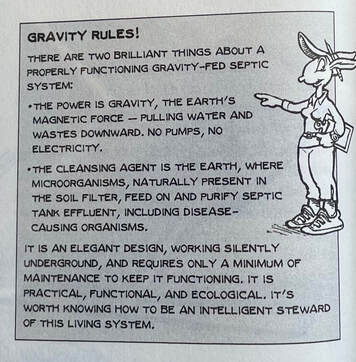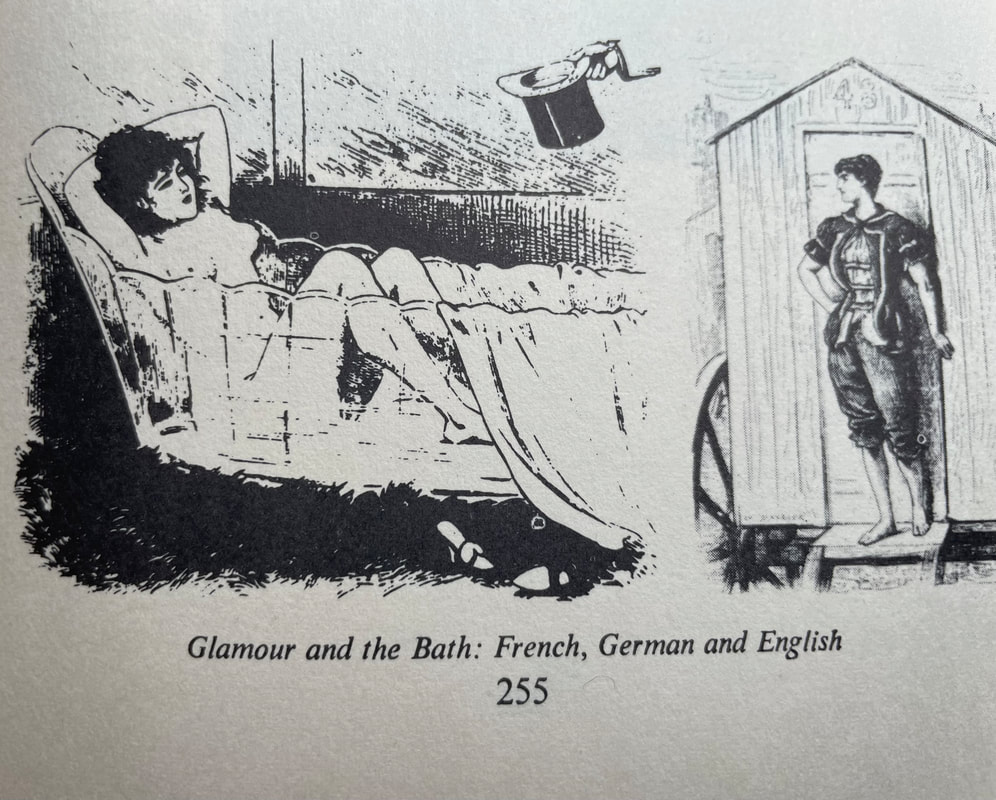|
Hello Readers. It’s ‘that’ time again. Instead of a close look at plumbers' materials and practices (as this space usually discusses) the author this time around wanted to tell his readers about two books he holds in high regard and believes they are perfect candidates for readers of In the Pipe. Home dwellers; builders; architects; plumbers; septic contractors; ‘pumpers’ and real estate professionals would all enjoy and benefit from the two titles represented. The reasoning behind discussing books instead of hardware was a simple choice: Pete thought he’d take advantage of an offer from Amazon to publish a book review on his Amazon’s “Author’s Page”. There are several titles that over many years the author believed the public would be well served to read, concerning plumbing’s history and functions. Pete the Plumber was recently invited by Amazon to submit three book reviews whence the company might pick one of them for publication. “Less is best”; “Fewer the better” (words) are terms authors subconsciously know are important to keep in mind when telling a story. Journalists are especially keen at this. (Me thinks Pete rightly avoided that latter art form.) At first Pete thought he could fulfill this 3 report challenge, until he read the ‘fine print”. What? Take the time to write 3 (hopefully) thought provoking works and have (with a great deal of ‘luck’) maybe one (1) selected for publication? After much procrastination (something he’s good at) Pete the Plumber was not very comfortable with those rules and odds. (Put in ‘all this work’ with no guarantees Amazon would use any of the three?) And not only go through the ‘self-flagellation’ of bumbling along in his signature loose, corny ‘Arthur Godfrey-ish’ labors, but write with an excruciatingly pared down word count? So. Well. Yours truly decided he would have more fun telling you about his book recommendations in his verbose mid-Western manner. Not only did this decision not scare Pete away from the challenge, but by roping 2 reports into one rotund-ish article the author had sufficient (minimum) word count to bother his editor, Anne. (She could pull the two reports into a Pipe piece, thus saving all the work to have the reports thrown into the ‘round file’, and Amazon will still publish the author’s two reports on the author’s running collection of blogs, at/on his author’s page. Is that being either sneaky or lazy? Or both? Now, you the reader, gets to decide (if you have the stamina). The first book Pete wanted to bring to your attention is: The Septic Systems Owner’s Manual If there was/were? just one book on a plumbing related topic that the author thinks should be read by the public at large, it is The Septic Systems Owner’s Manual. (I can hear you laughing.) But it’s no joke. About 25 million septic systems are operating in the U.S. and each year 400,000 new ones are added. That’s millions of people making the average 1lb. of their poop a day their responsibility for sanitary disposal. Now, what might you think this has to do with the rest (majority) of the population living with paid municipal sewerage privileges? A realization is now forming in the minds of forward-thinking sanitation professionals that the present model of municipal, centralized, pool enabled sewage and wastewater treatment facilities face a troubling future due to climate change. (At some point no longer enough water). Experts have been late to understand that our drinking water wasting sanitation model might not be feasible at some future date (possibly sooner than later). Opposed to our present model of ‘municipal centralized/pool processing, our long-proven septic (de-centralized) designs at some point in our future may need to ‘save’ us from no longer working, energy gobbling, high maintenance ‘pool’ methodologies. (Now “no worries Mate”). This great threat probably/might not/ won’t occur in a few short years’ time. But by reading (now) The Septic System Owner’s Manual, if you do happen to still be breathing at the unfortunate time of ‘Poop Armageddon’, you’ll have the good sense to go move-in with your old Aunt Edna, out on the ‘outskirts’. Understanding how human liquid and solid waste (thanks to ‘bugs’) in conjunction with soils is made into a safe “afterthought” is the chemistry lab probably most of the Country would now flunk. However, invest the little time to read this book (and thanks to its author, Lloyd Kahn, and illustrator Peter Aschwanden ) it’s a very humorous read to boot. You’ll be fully schooled in this extremely important fact of life and ready to attend your next class reunion (with lots of new gosh bathroom humor for ‘ammunition’.) Bonus Not only are septic systems fully discussed but included is a invaluable chapter on gray water systems which will be playing an ever more important role in our modern hygiene existence. Happy, Fun Reading… PtP Clean And Decent, By Lawrence Wright Hello Again, Now in this, the second review, the author fondly recalls many service calls to homes of customers who over the years became good friends. Luckily for Pete a goodly number of these customers-into-friends were also very good cooks. And even more fortunate for Pete (who owns an insatiable appetite), not only a few enjoyed feeding the author. Yours truly truly understands the passage: “Have your cake and eat it too.” Who, ever, had a gig as good as that?!?! Me wagers not many. Matter of fact, one of Pete the Plumbers most coveted accounts was a world class fine dining venue. Over the years Pete and the head chef formed a wonderful bond, and the plumber became also the home plumber for his chef. On one particular ‘light workload’ day the author got a hankering for some good food and proceeded to his friend's restaurant. As usual, when Pete would appear, the Maître d would announce his arrival. On this particular visit, the chef told Pete that quail was on the menu. “Oh…I just love quail” said Pete, “but they’re not especially filling.” “Well, how many of the little birds do you think you can eat?” said my friend. “At least five,” Pete told him. “We’ll see,” said the chef and Pete was seated. (Yours truly devoured all of them.) Another true friend/client of Pete’s was a Geography Department Chair at a world-famous university. This professor was not in need of his university salary due to inheritance. The educator’s kitchen looked like a commercial kitchen supply store. Pete’s friend (a gourmand) was known to fly to Paris to procure mustards. This professor happened to enjoy occasionally cooking for a select group of his postgraduates, and on some those occasions would call Pete, the day before, and invite him to attend. Those occasions were always jocular ones, and the author always happily answered any questions involving plumbing (which always arose). At one of these feasts, following the final exit of the student guests, Pete’s professor friend pulled a book from a shelf and handed it to the author, telling him that “…every plumber would be well served by reading it.” The book? “Clean And Decent”. This plumber has thanked his mentor’s gift of Clean And Decent for opening many conversations among Pete’s plumber friends and prospective clients alike. (Reading this book of plumbing’s historical progress makes one so glad they are alive now…not then.) It is a most enlightening, enjoyable and profusely illustrated history of bathing, pooping and other personal hygiene habits of mankind. It is actually pure enjoyment masking a rather scholarly endeavor. With reading we discover the first known advertisement for a house with a bathroom was in a Paris newspaper of 1765. (Real estate agents paying attention?) Another: In 1908, in London, there was one municipal bathtub for each 2,000 inhabitants! Or: In 1851 a bathtub was installed in the White House. (We know it wasn’t a cast iron one because those weren’t on the market until 1880.) And, it wasn’t until 1910 that porcelain bonded cast iron fixtures became available. Lots of fun such facts, wonderful historical illustrations, but attitudes are also noted. Example, page 41, last 4 sentences: “In medieval stories of amorous intrigue, the two lovers usually begin their evening by bathing together. Ideas of propriety were different from ours; the whole household and guests shared the one and only sleeping apartment, and wore no night-clothes until the sixteenth century. It was not necessarily rude to be nude. Home life seems to have combined luxury with discomfort, and a strange indifference to privacy.” The biggest takeaway (for Pete) from reading Clean and Decent is a reinforced appreciation for our present-day level of ‘sanitary convenience’. The common man is living a lifestyle that even kings and royalty could have only dreamed of. Clean and Decent is a fulfilling and entertaining account in text and illustrations of man’s sometime wobbly progress along the path of increasing our knowledge and practice of personal hygiene. By taking Pete’s cue and setting aside time to digest this recommended read, at some future social gathering the read reader will be able to amaze his/her fellow attendees with encyclopedic factoids (when inevitably) the suffering conversation ‘comes round’ to irritating bodily ‘shortcomings’. And, by all means take up the challenge on Page 7: Until next time, P.t.P.
0 Comments
Your comment will be posted after it is approved.
Leave a Reply. |
Author
Peter Hemp is a San Francisco East Bay residential plumber and plumbing author and former R & D steam vehicle plumber. His hobbies are ocean kayaking and touring the Left Coast by bicycle. Archives
September 2021
Categories |
|
|
Copyright © 2017 - 2022
All Rights Reserved
All Rights Reserved














 RSS Feed
RSS Feed